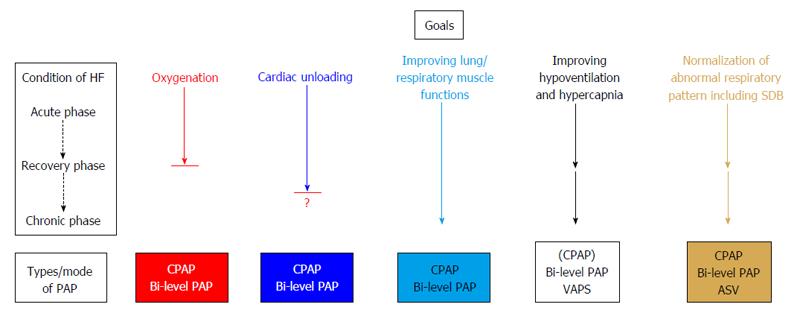Copyright
©2014 Baishideng Publishing Group Inc.
World J Cardiol. Nov 26, 2014; 6(11): 1175-1191
Published online Nov 26, 2014. doi: 10.4330/wjc.v6.i11.1175
Published online Nov 26, 2014. doi: 10.4330/wjc.v6.i11.1175
Figure 8 Importance of each goal of positive airway pressure therapy according to different heart failure conditions.
In the wide spectrum of HF care, PAP therapy is used to help oxygenation, provide relief from cardiac load, improve lung and respiratory muscle function, reduce hypoventilation and hypercapnia, and normalize abnormal respiratory patterns, including SDB. The importance of each goal can differ according to the condition of HF. Improving oxygen is one of the most important goals in the acute phase. However, after recovery from acute decompensation, this goal becomes less important or is no longer considered. Providing cardiac unloading is another important goal in the acute phase to the recovery phase. However, the importance of this goal remains to be elucidated after recovery from acute decompensation. Improving lung and respiratory muscle function is sometimes important in the acute phase and after recovery. Improving hypoventilation is important in cases with hypercapnia in the acute phase. In addition, HF patients with hypoventilation and daytime hypercapnia can be treated by PAP therapy in the recovery or chronic phase. Normalization of abnormal respiratory patterns, particularly SDB suppression, is sometimes important in the recovery phase and is most important in the chronic phase. The specific types/modes of PAP that should be used differ according to each therapeutic purpose. ASV: Adaptive servo-ventilation; CPAP: Continuous positive airway pressure; HF: Heart failure; PAP: Positive airway pressure; SDB: Sleep disordered breathing; VAPS: Volume assured pressure support.
- Citation: Kato T, Suda S, Kasai T. Positive airway pressure therapy for heart failure. World J Cardiol 2014; 6(11): 1175-1191
- URL: https://www.wjgnet.com/1949-8462/full/v6/i11/1175.htm
- DOI: https://dx.doi.org/10.4330/wjc.v6.i11.1175









